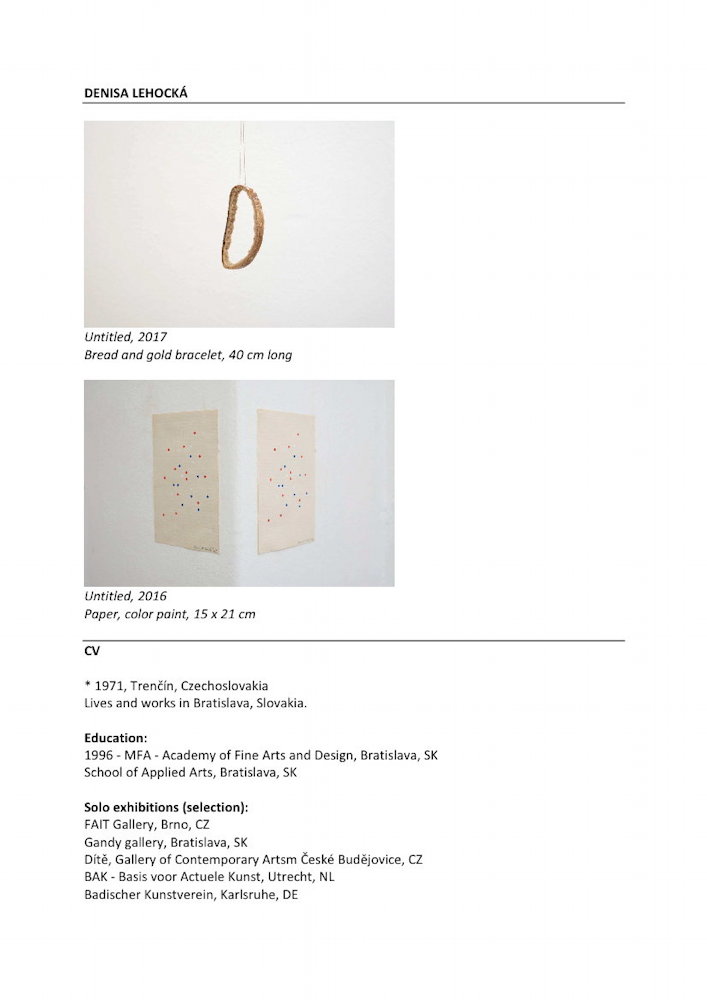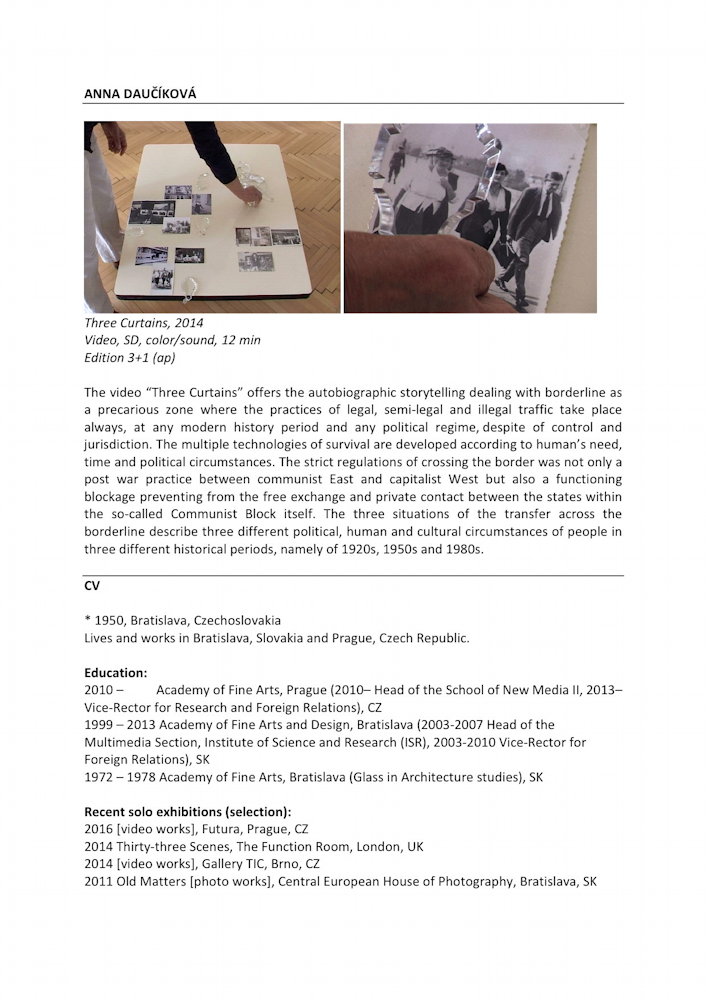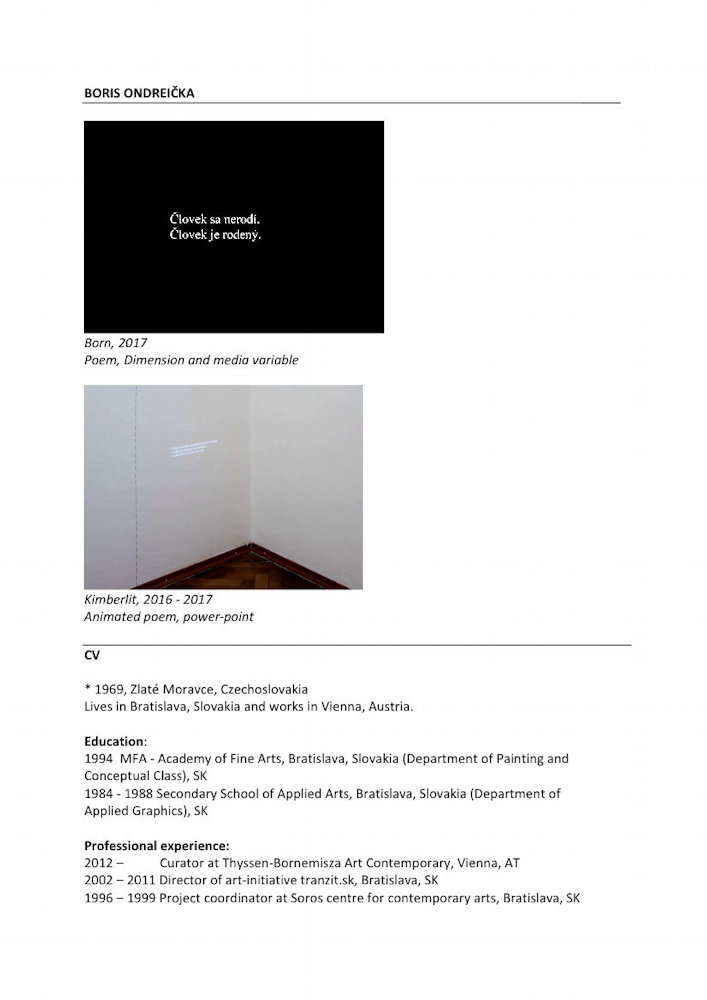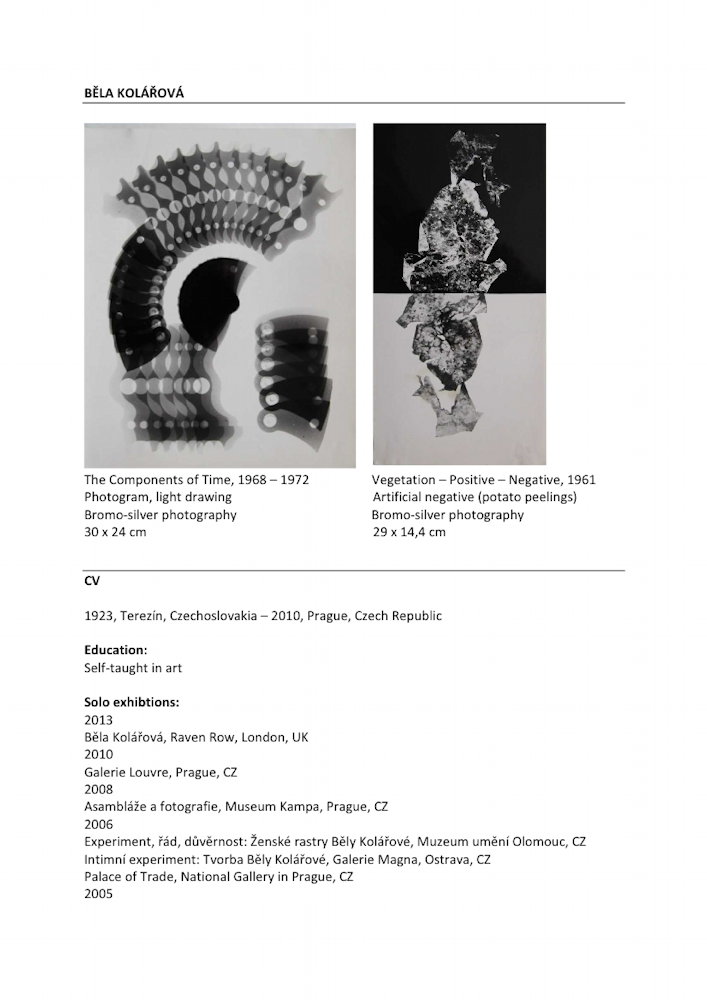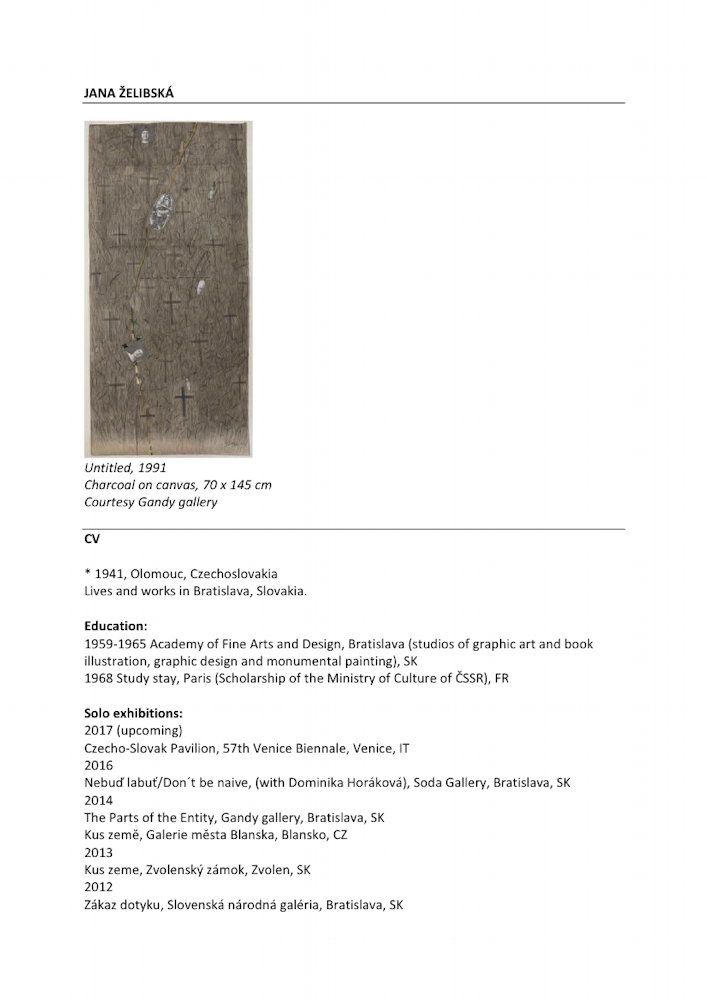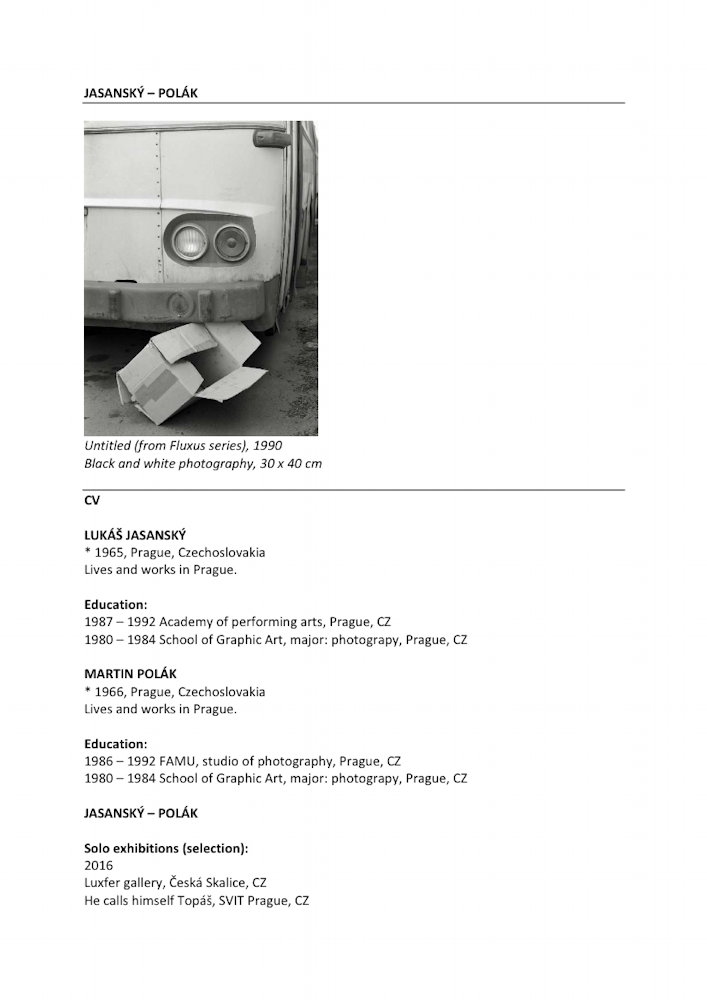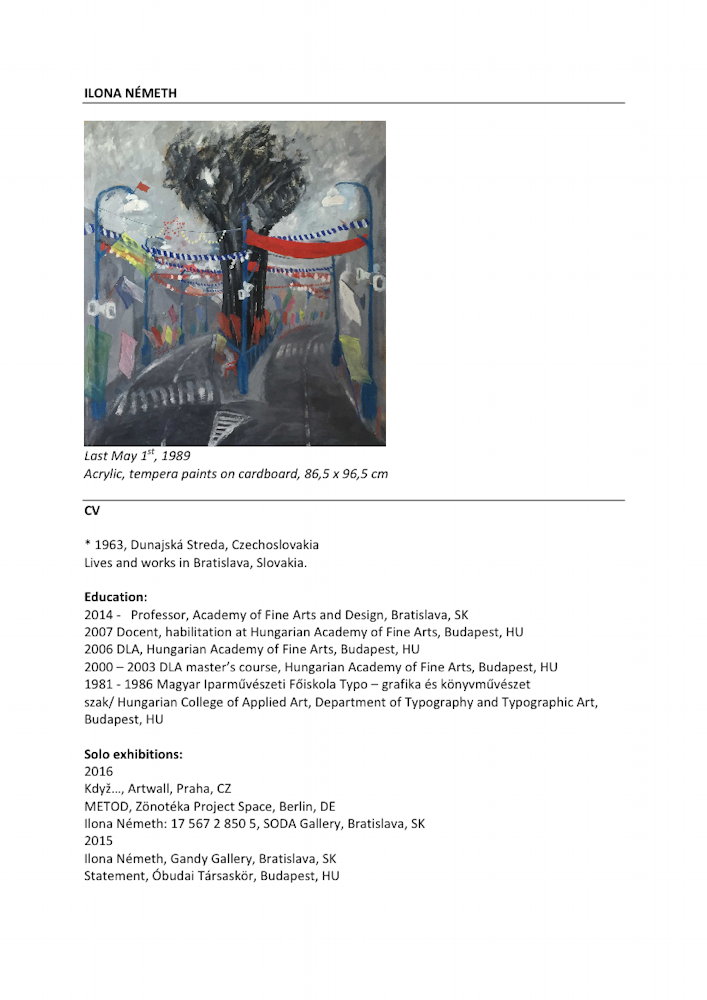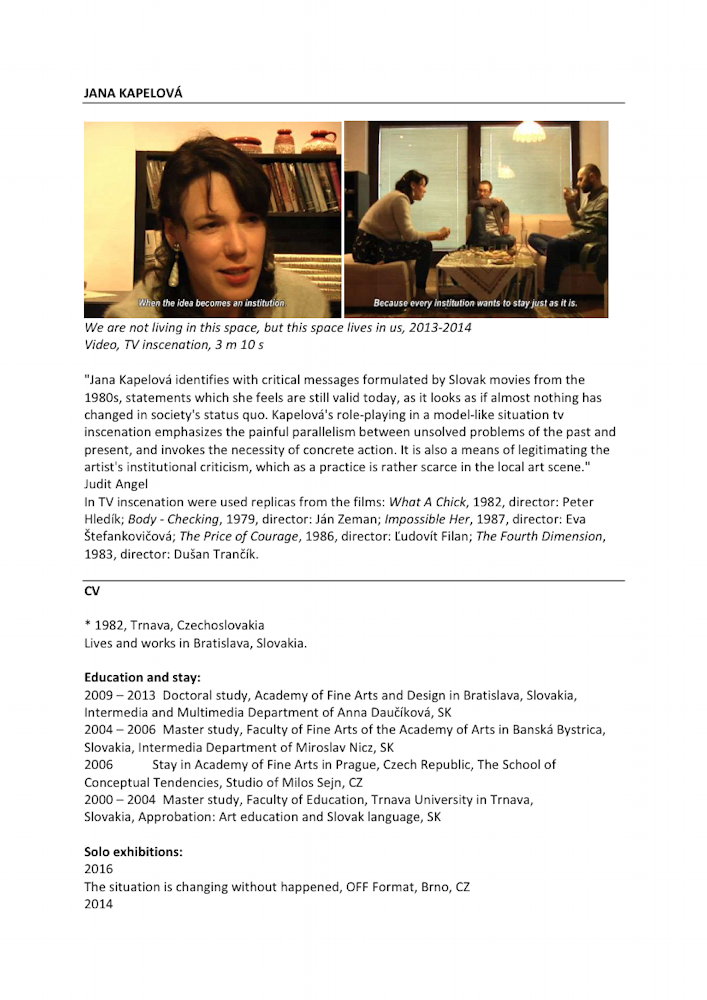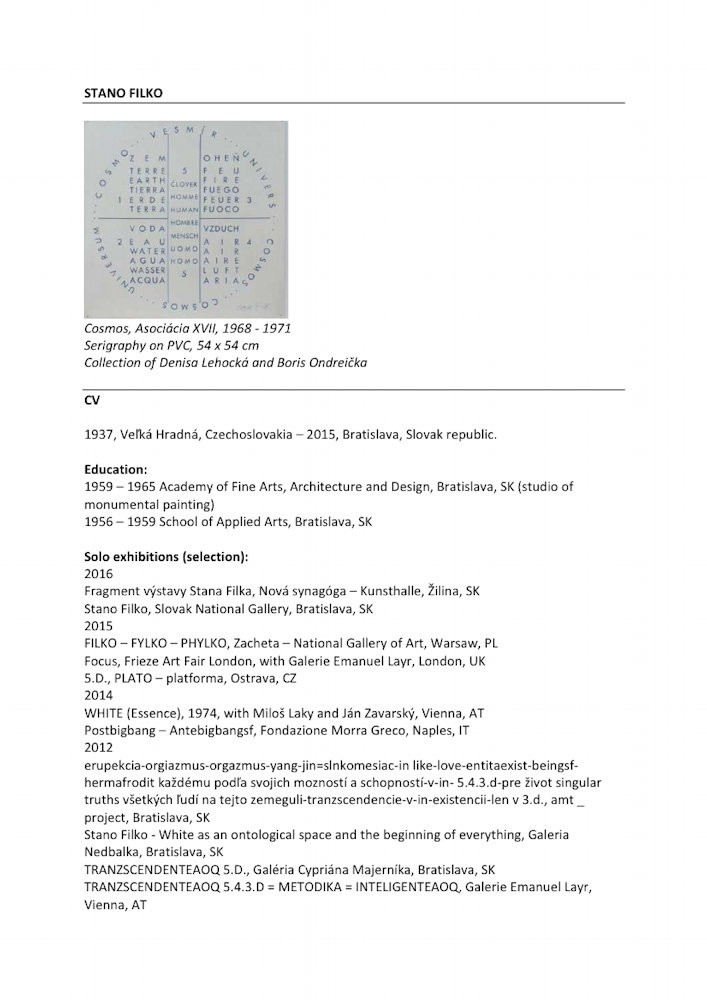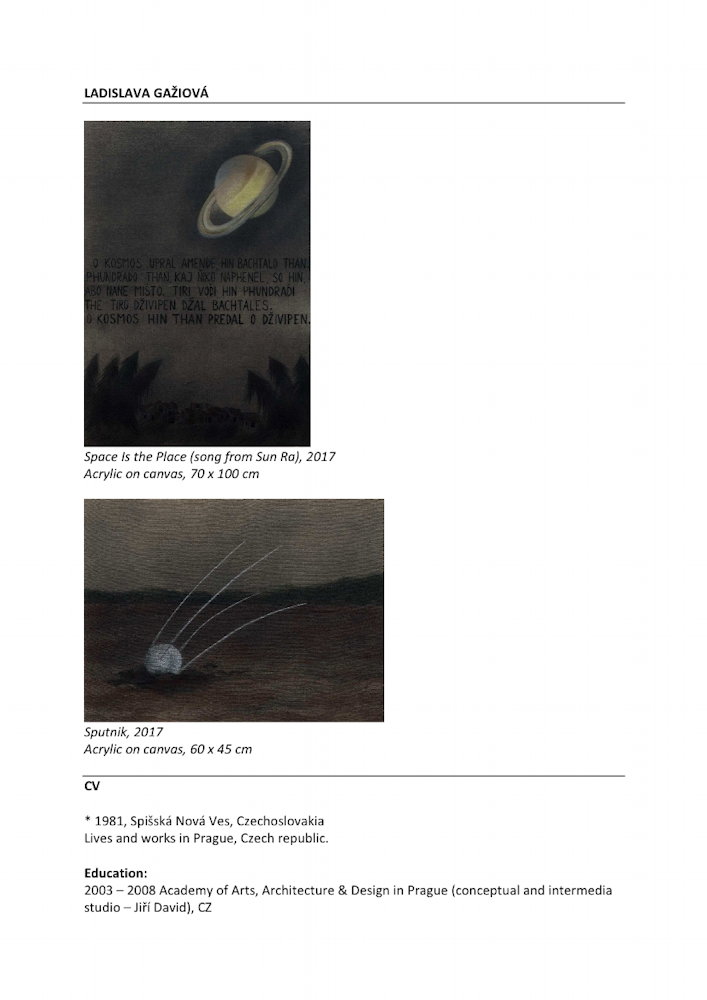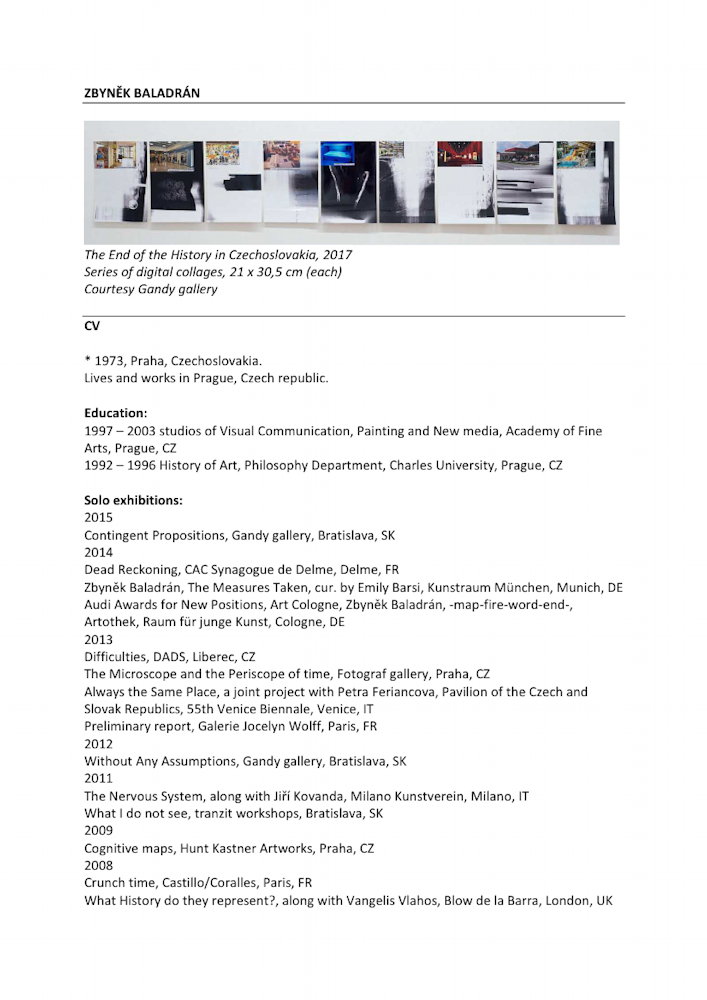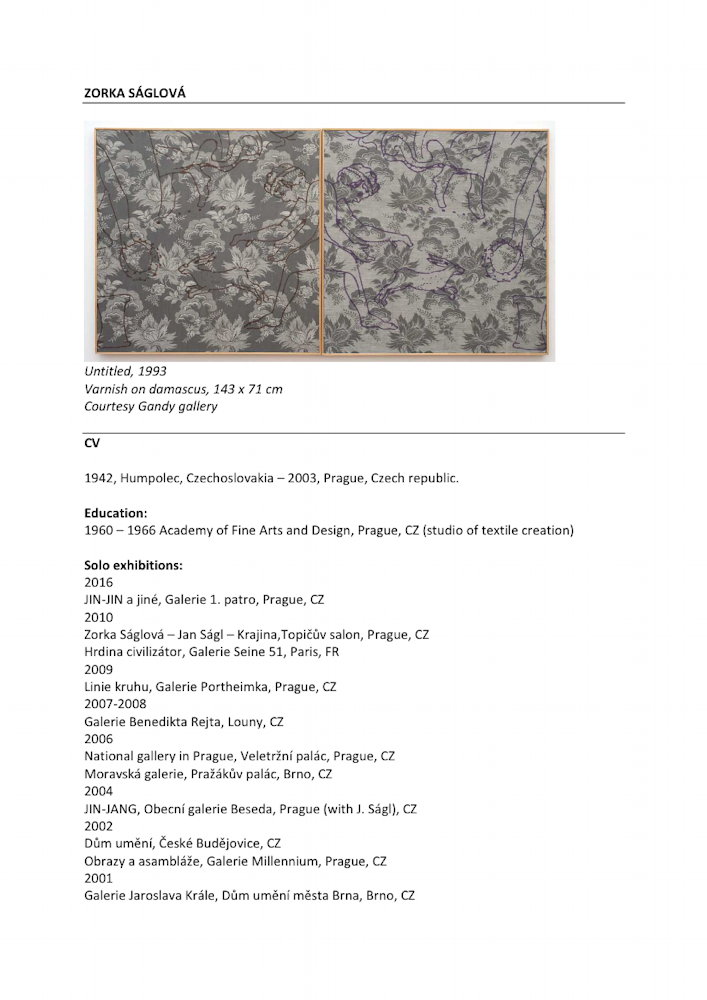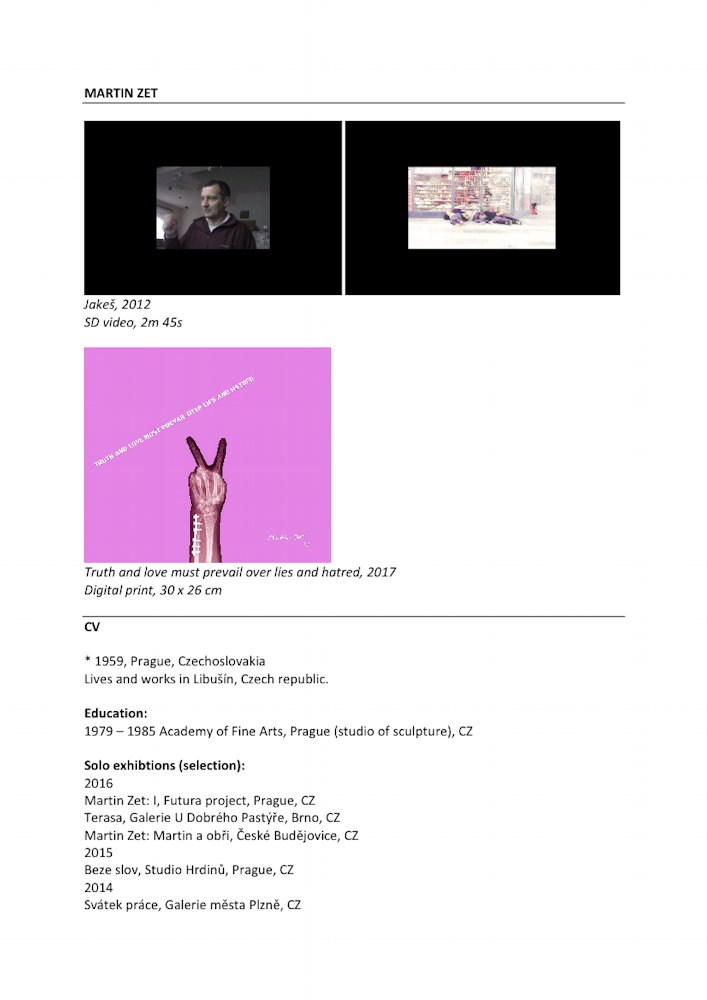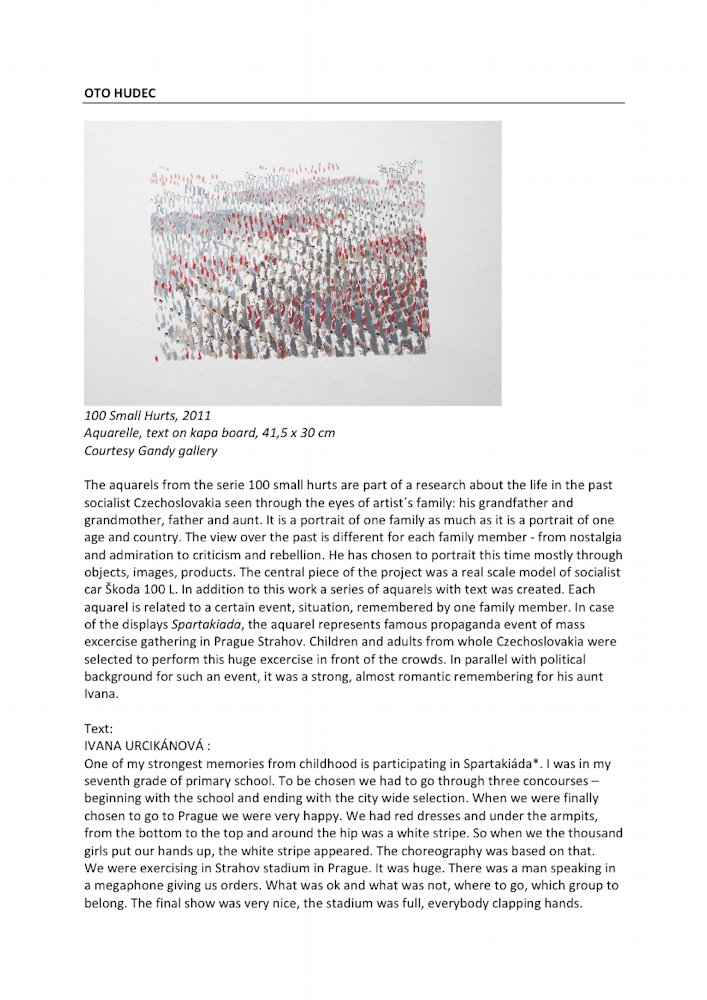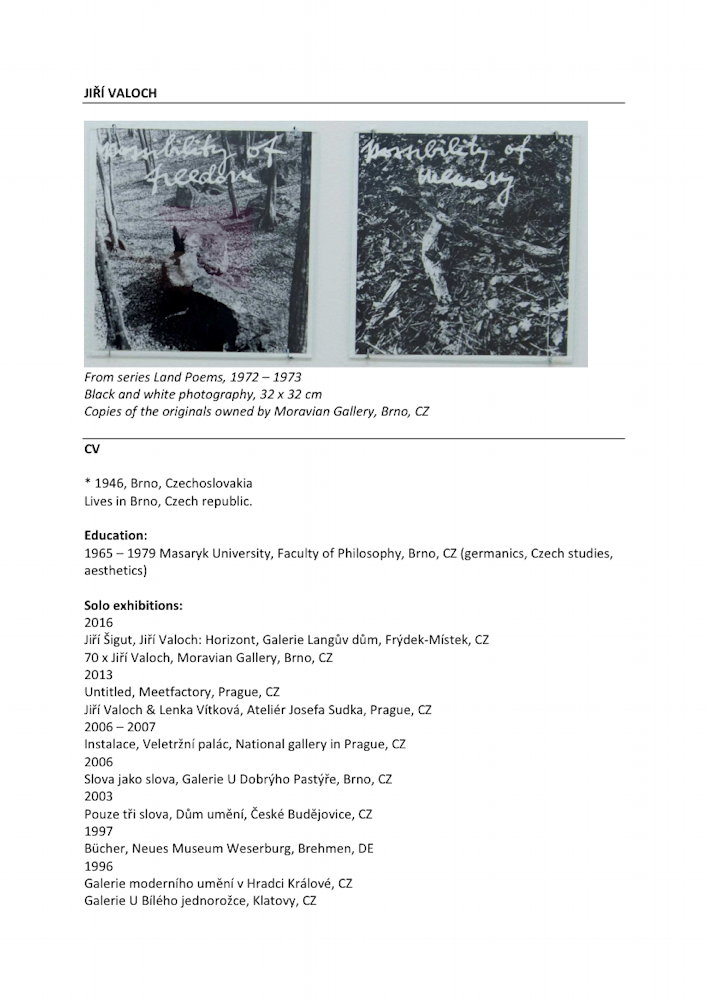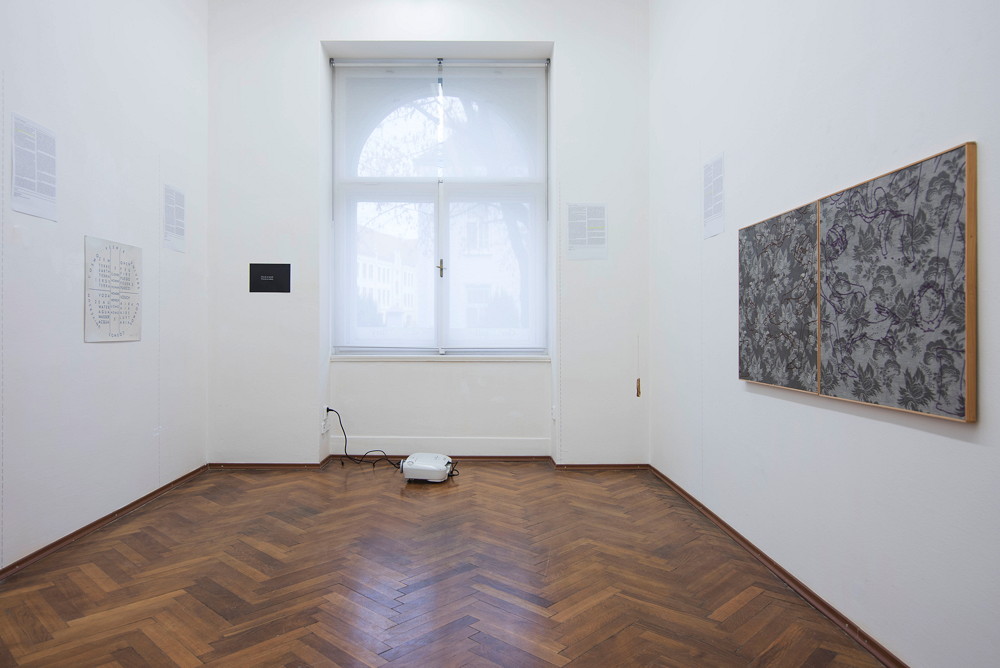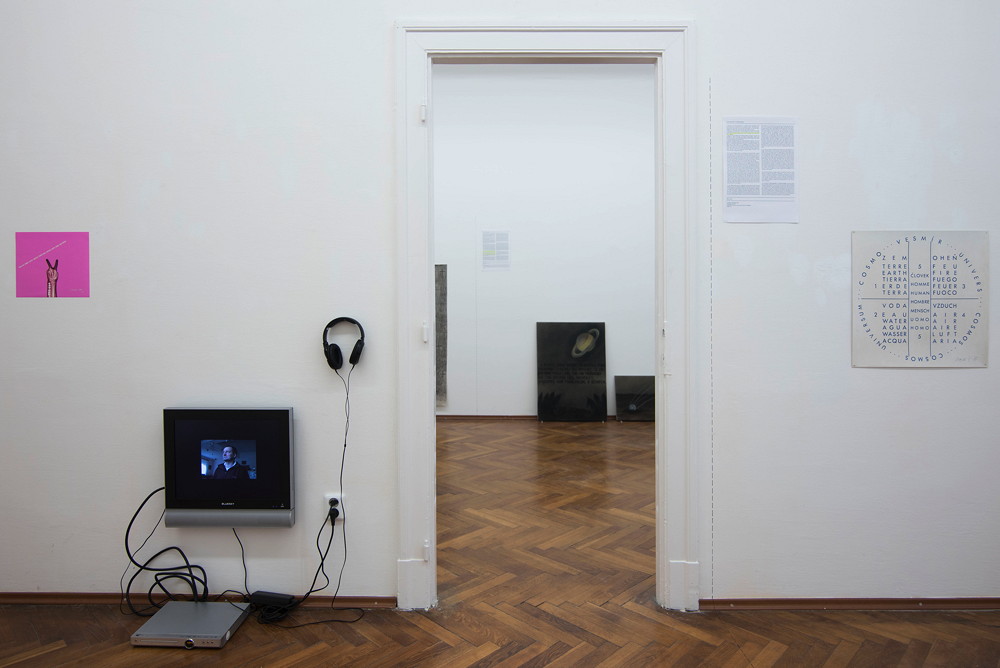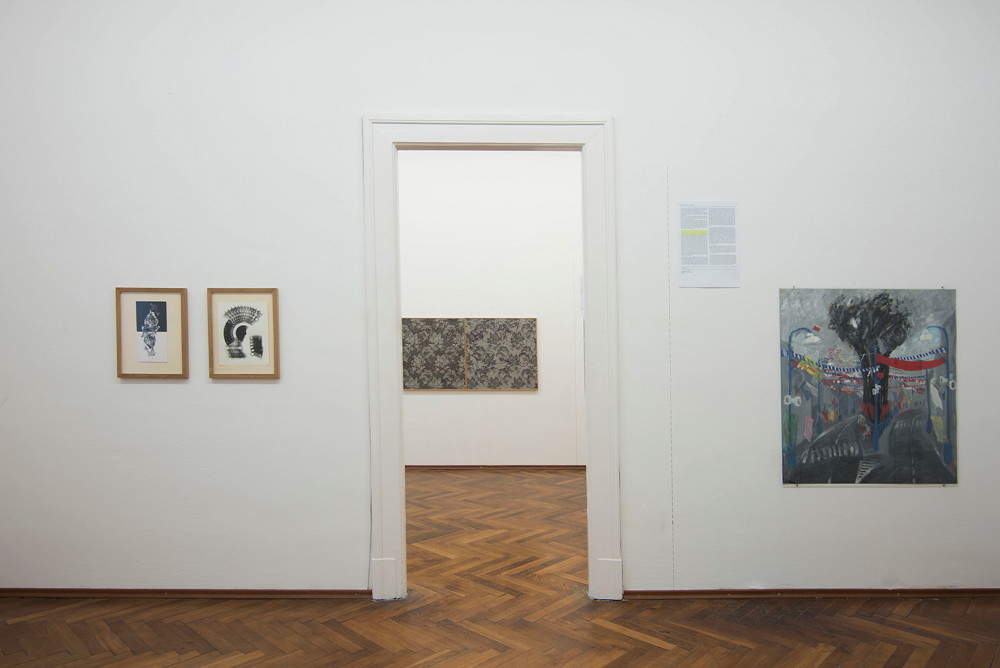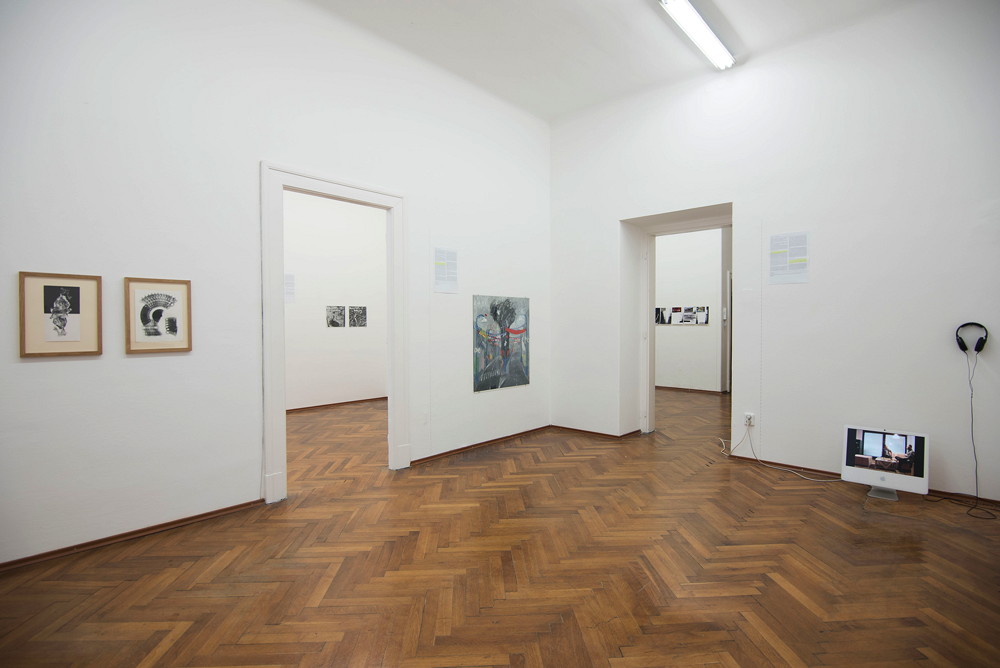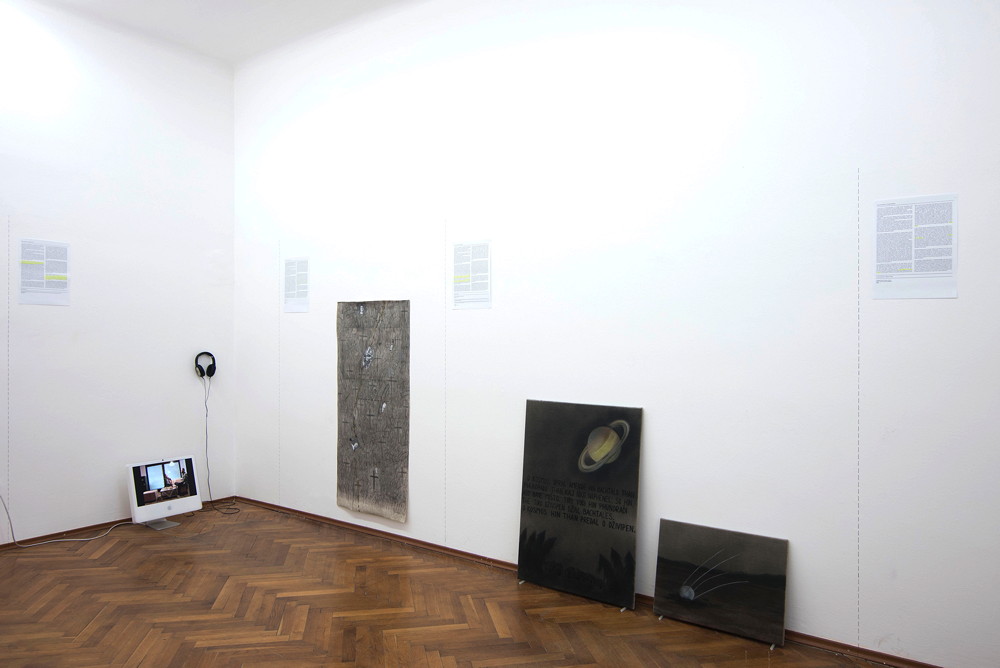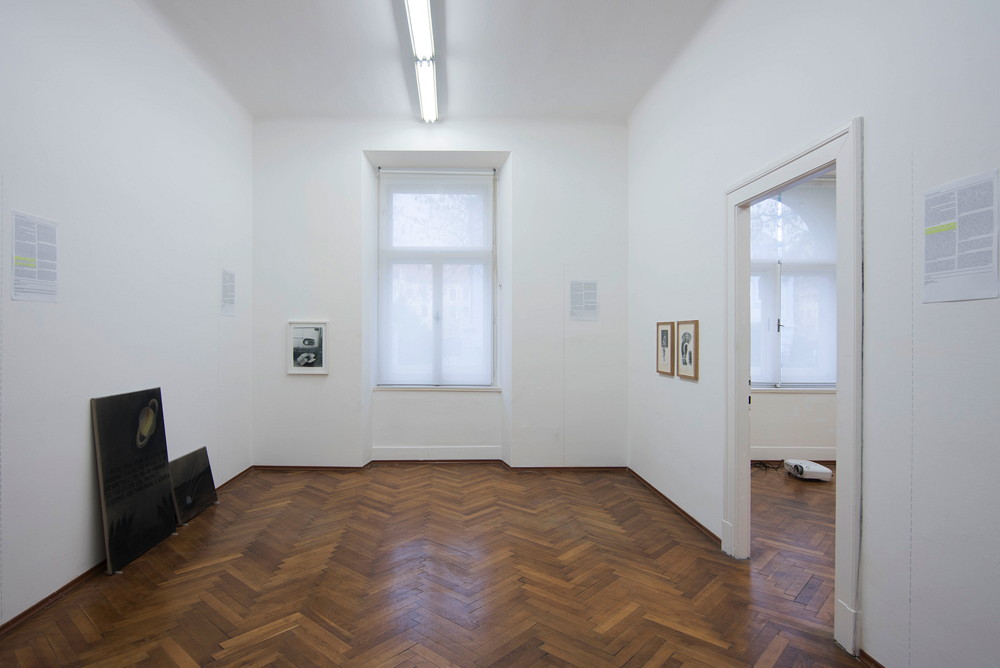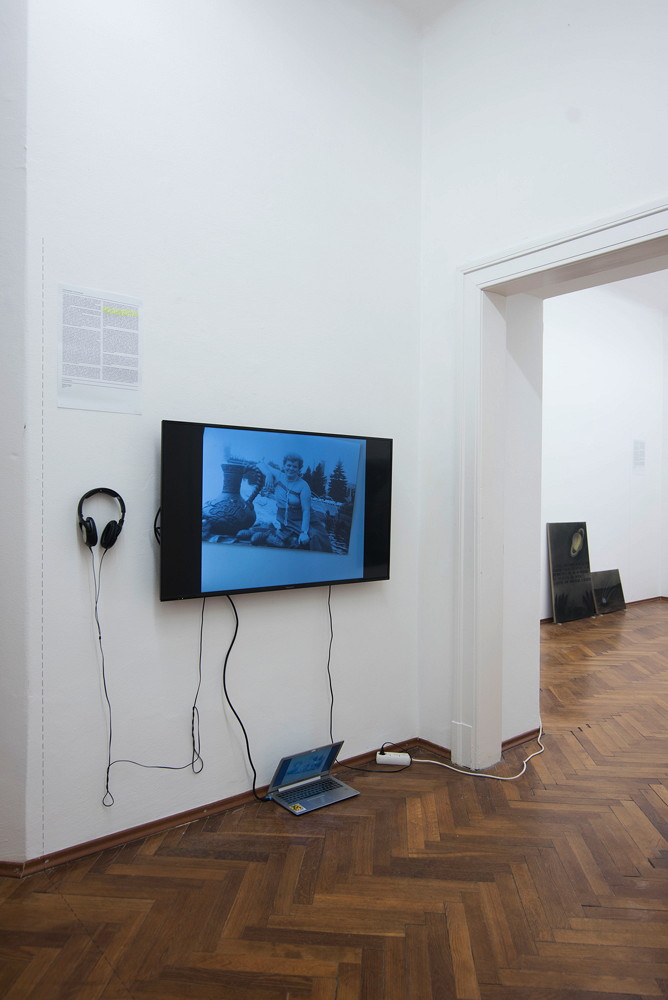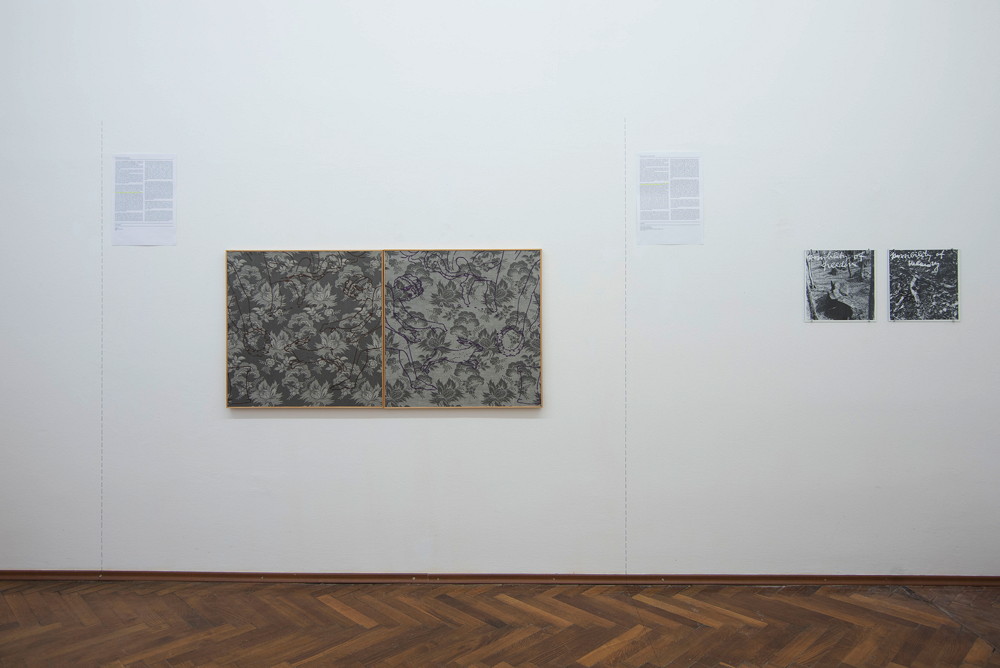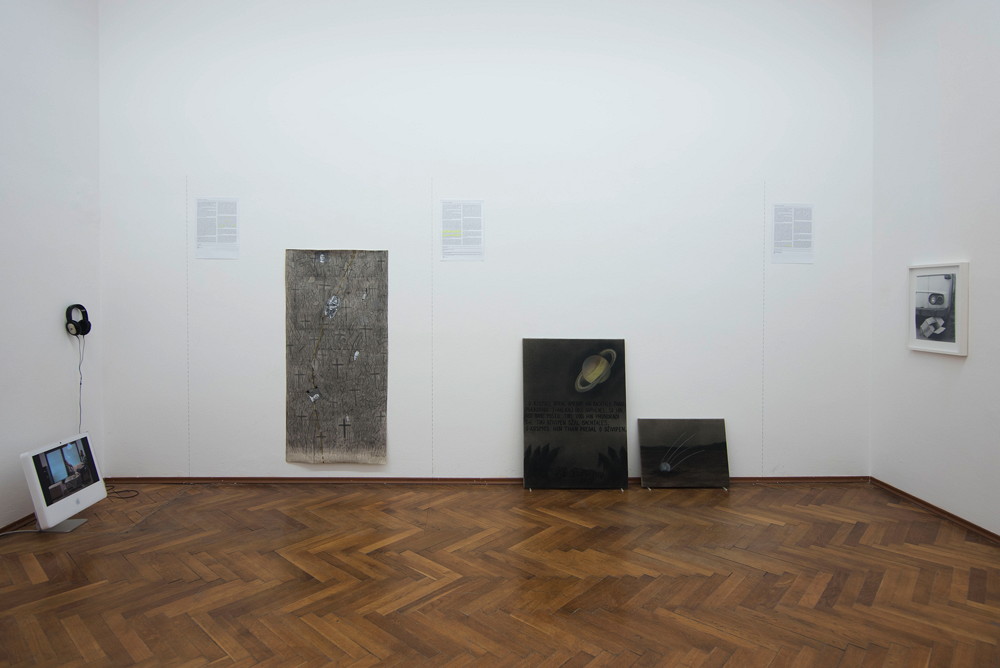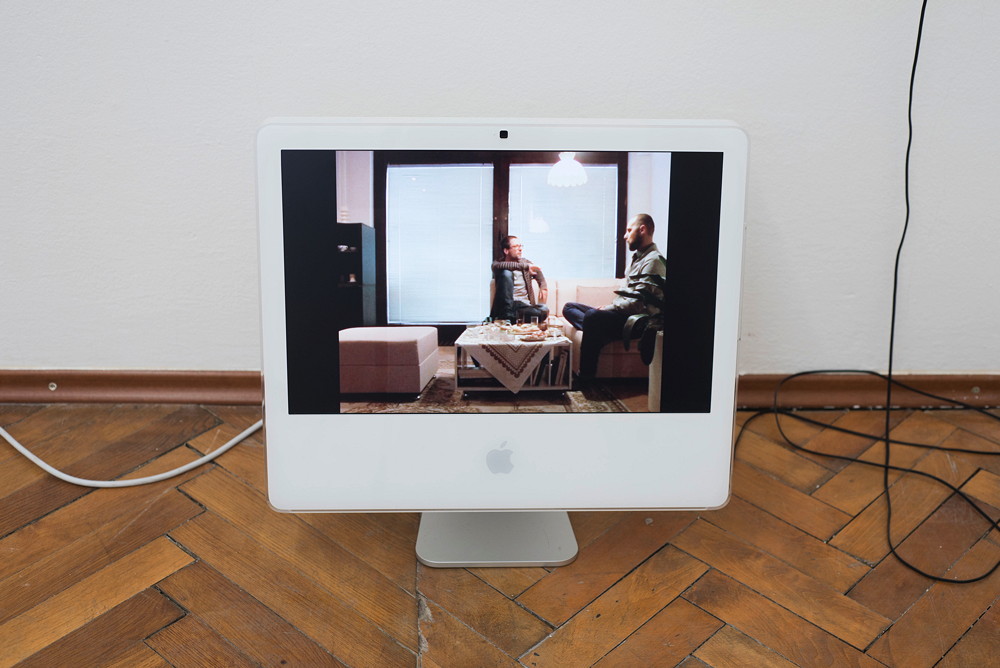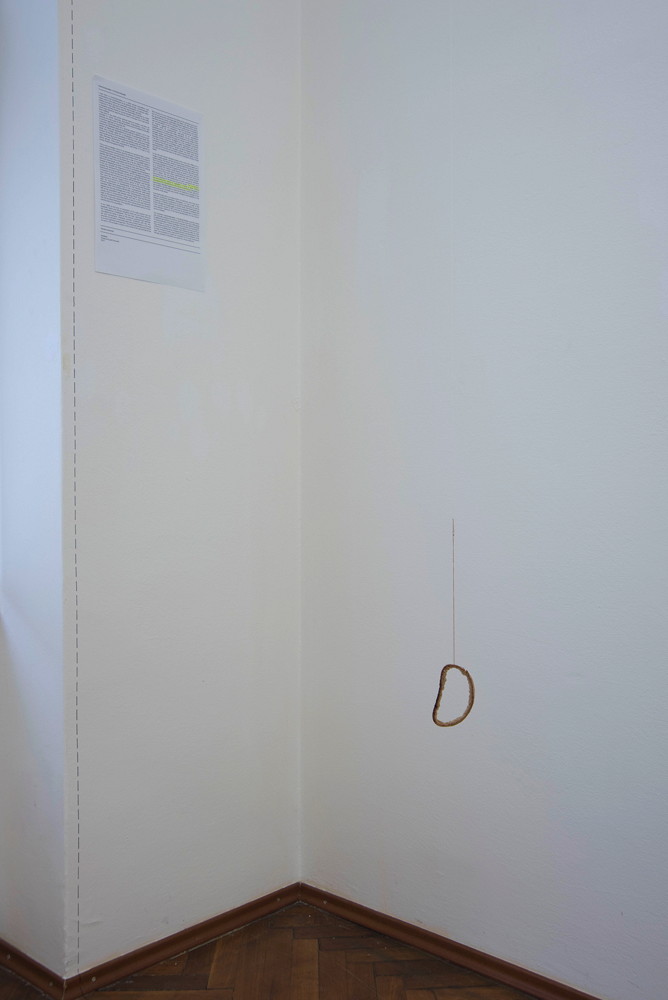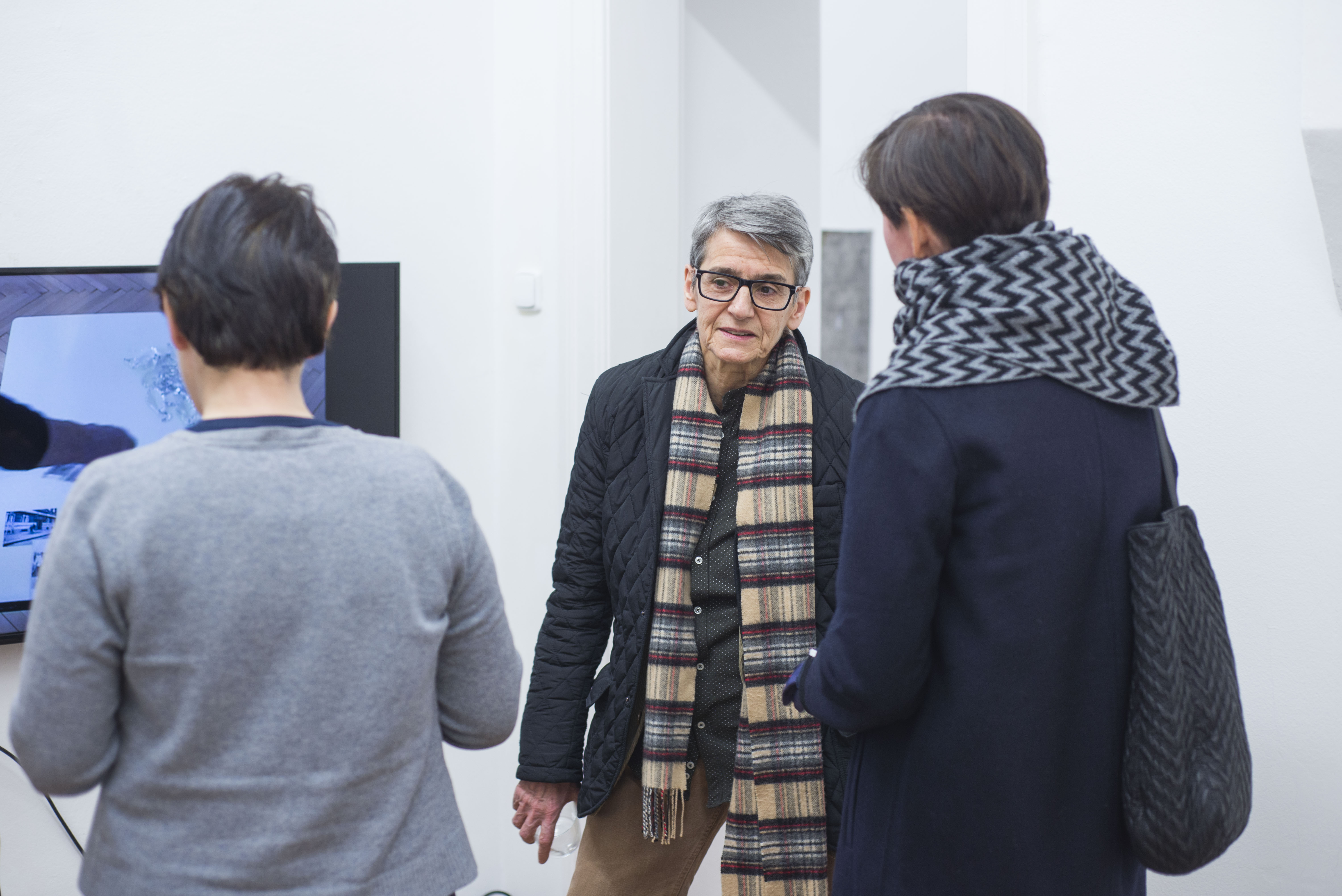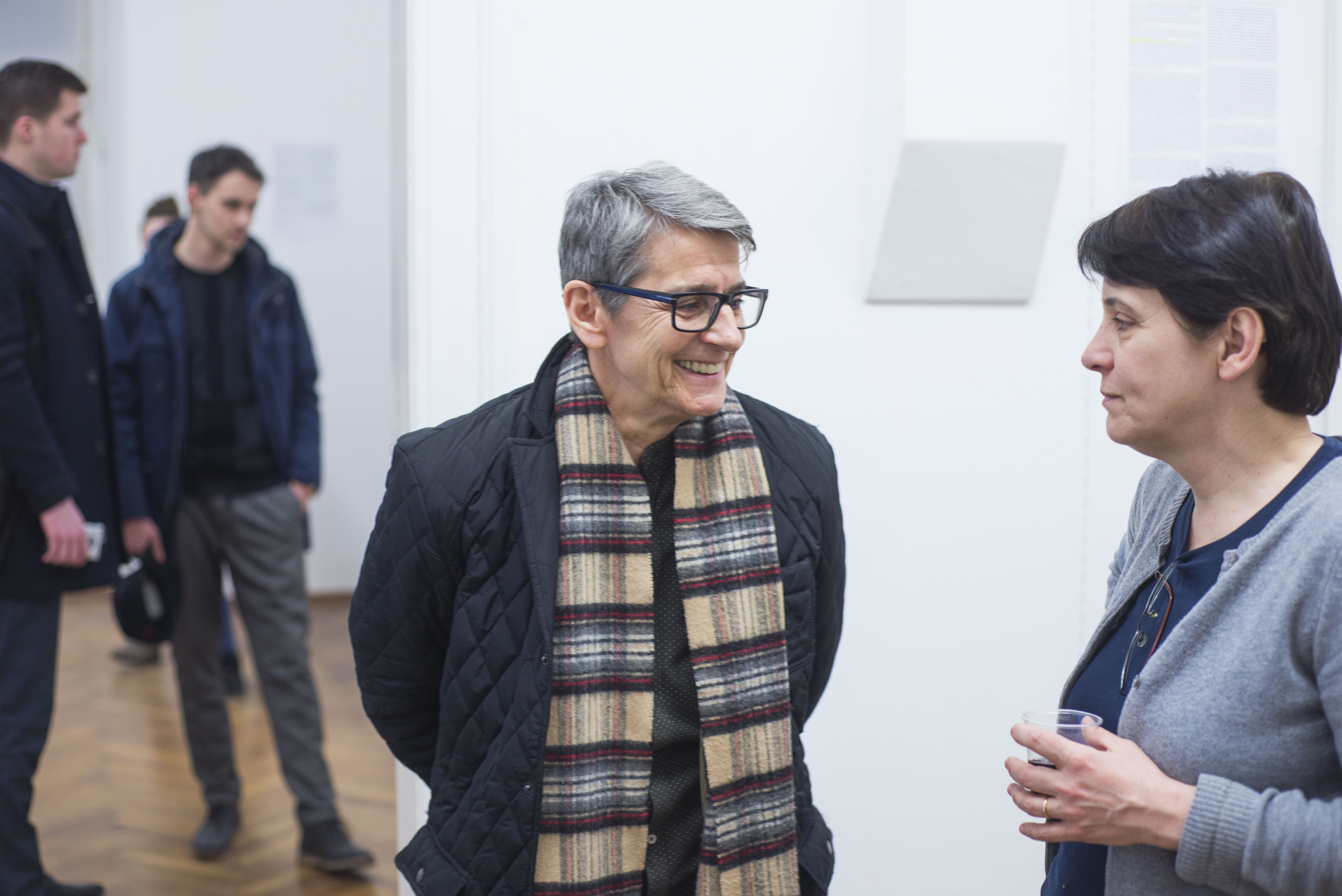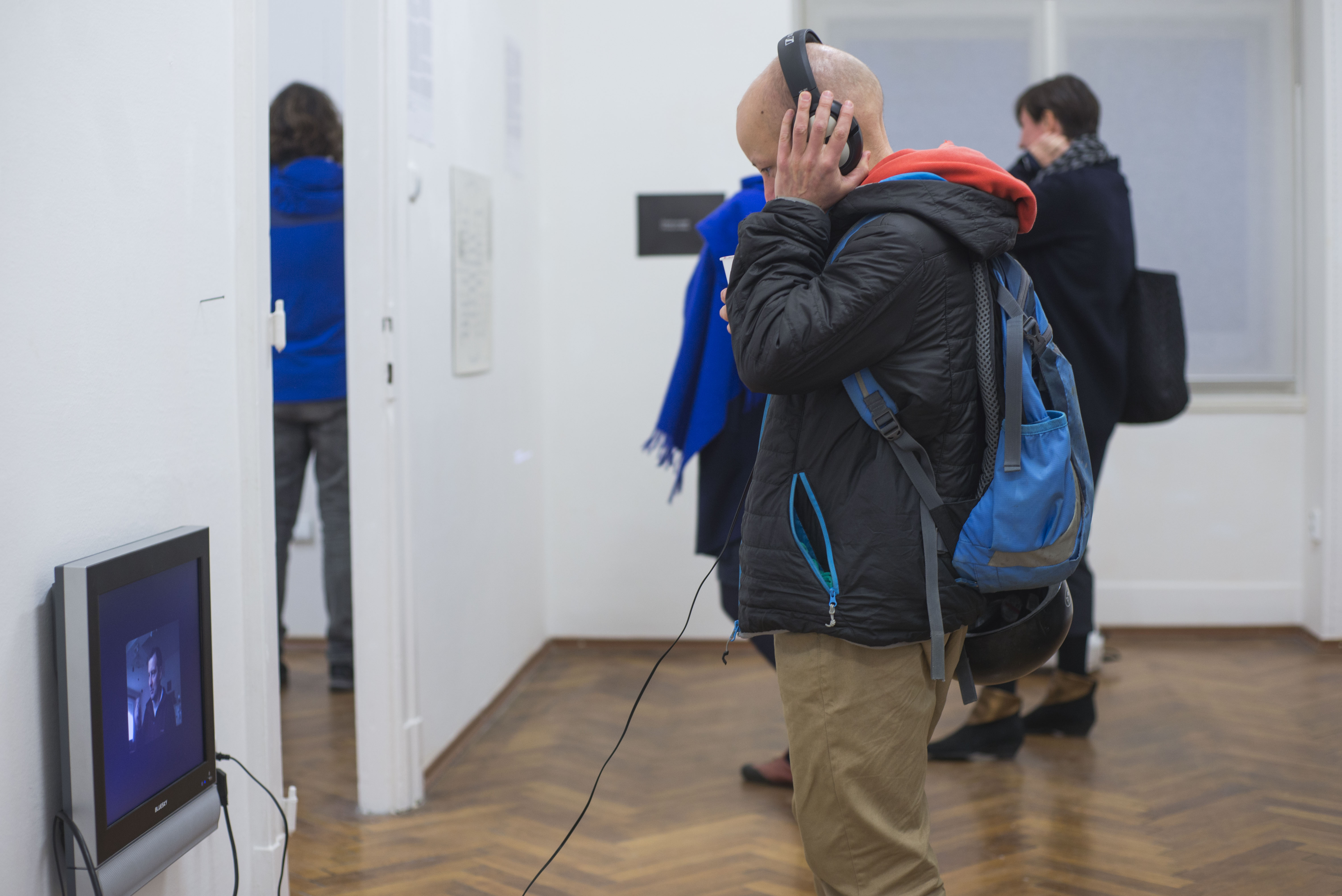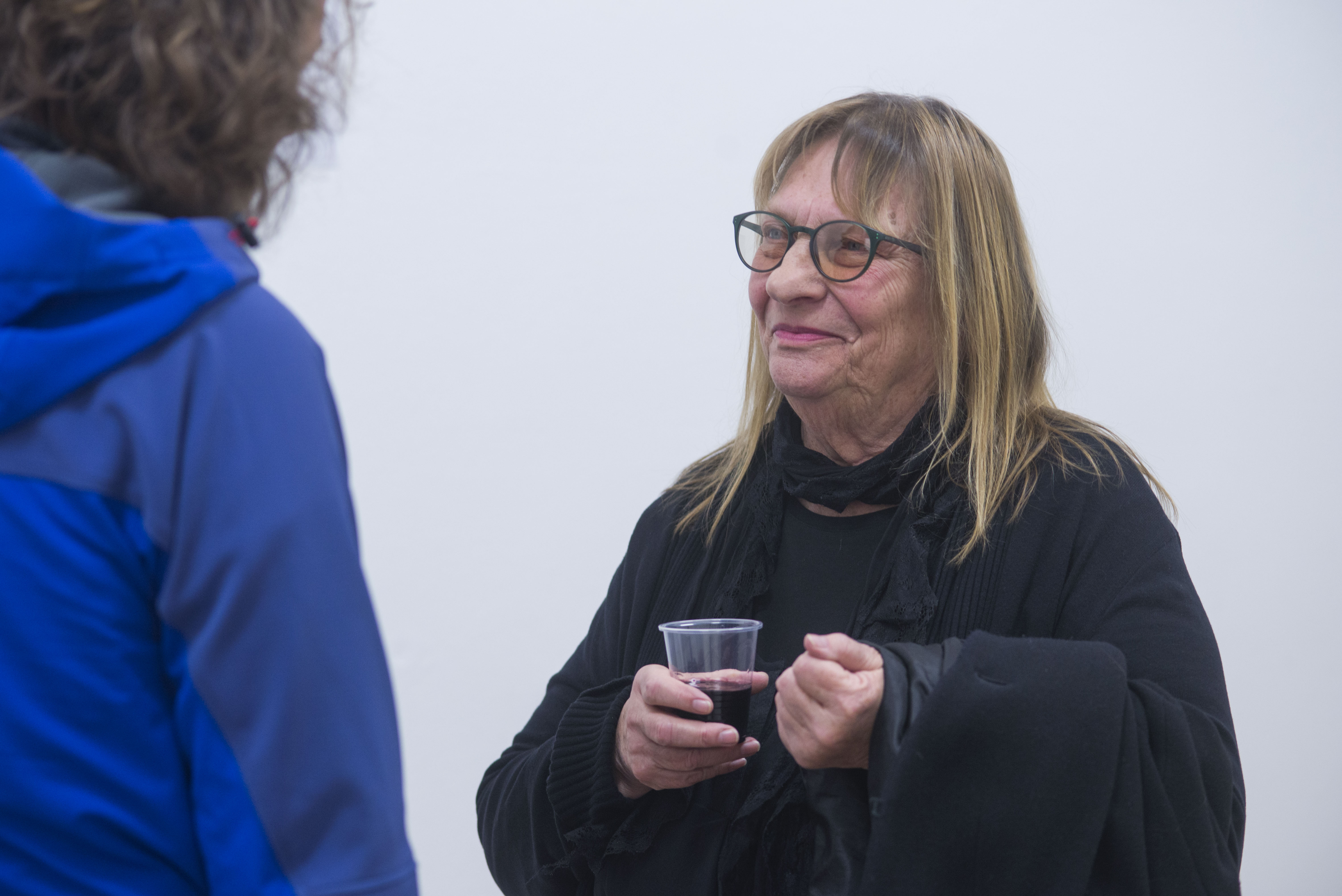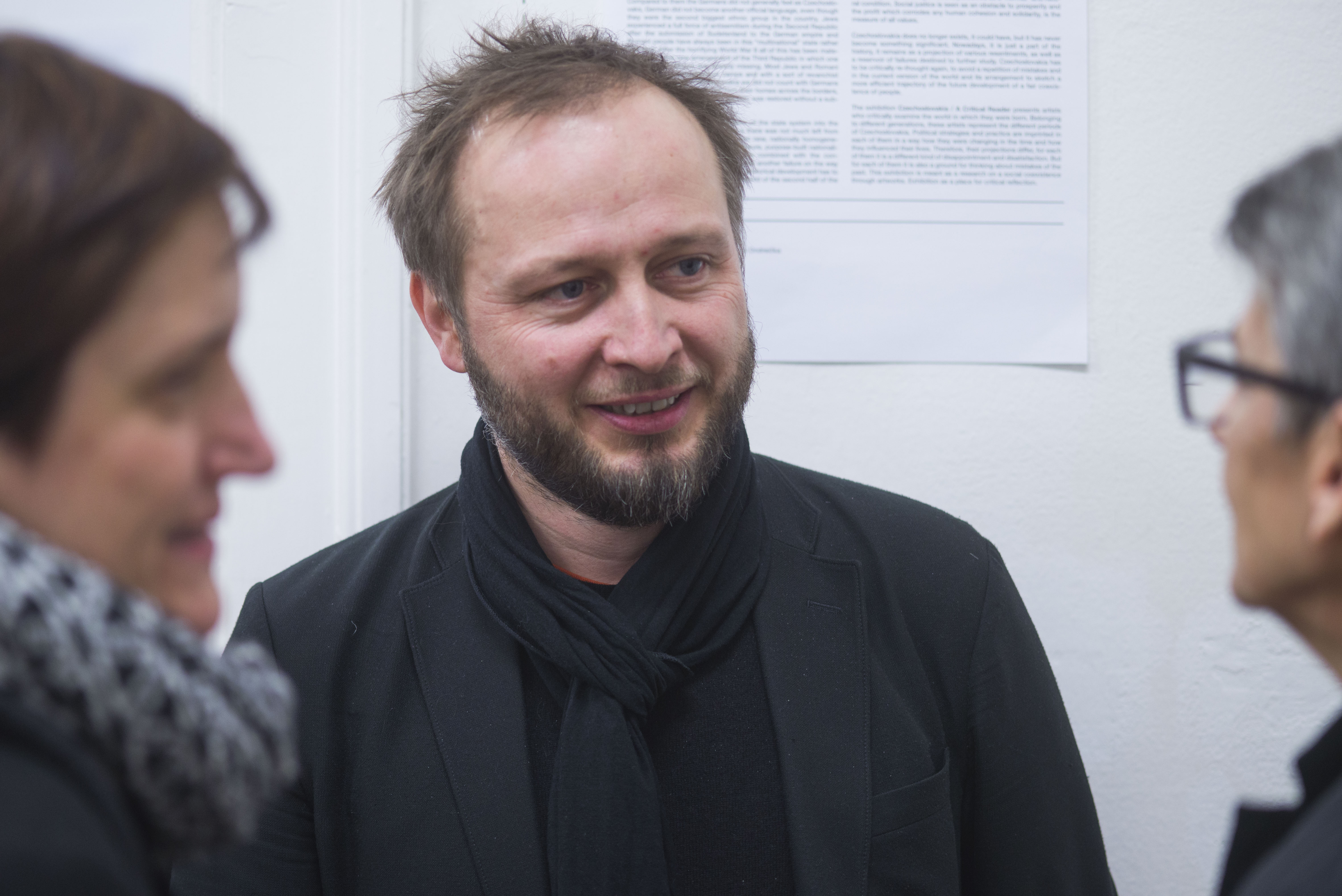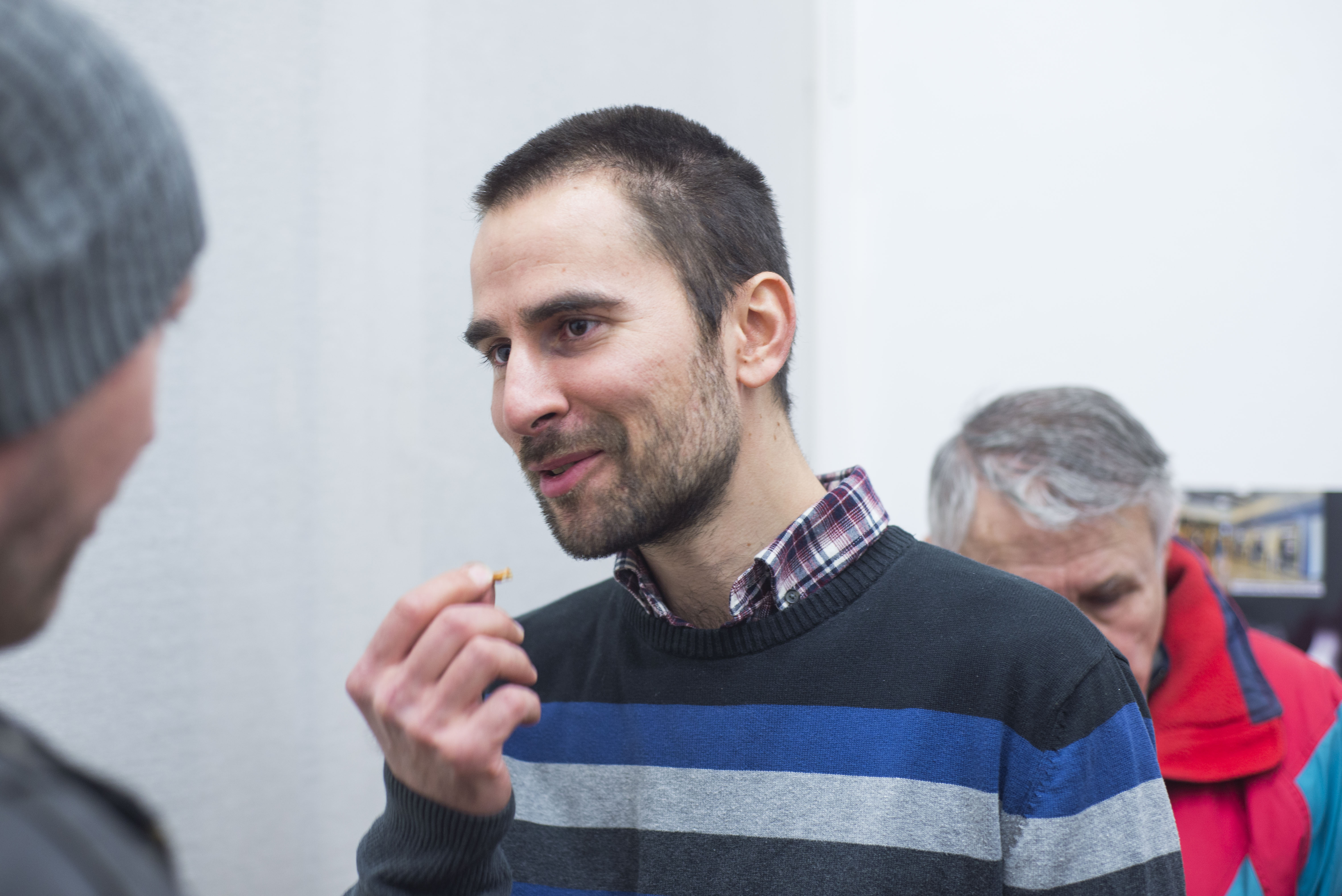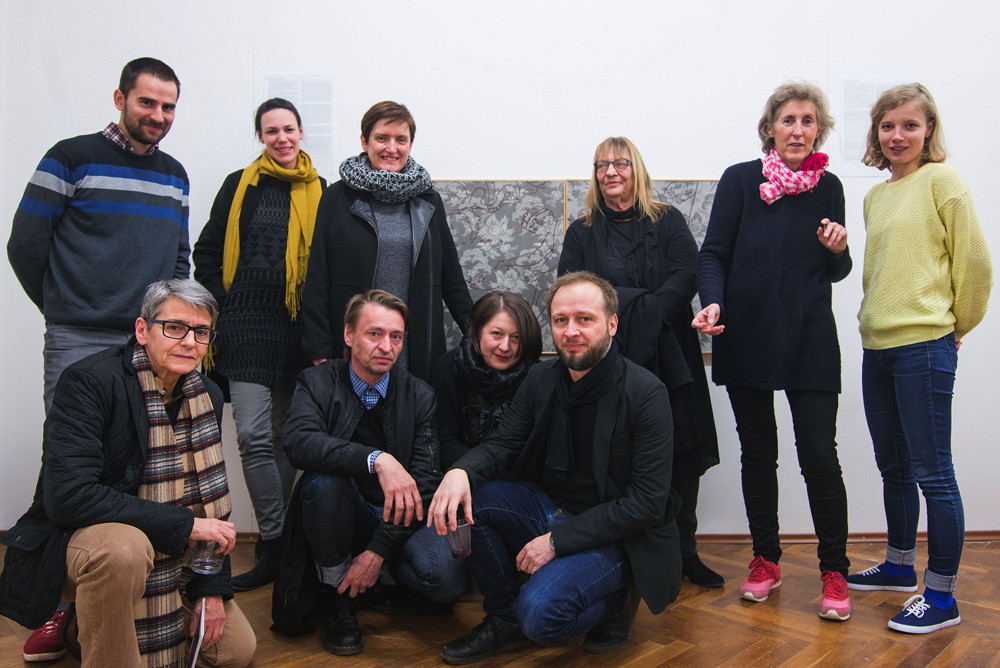Czechoslovakia
Bratislava

CZECHOSLOVAKIA / A Critical Reader
At the occasion of 25th anniversary Gandy gallery is pleased to announce the opening of a group show entitled "Czechoslovakia / A Critical Reader"curated by Nadine Gandy and Zbyněk Baladrán. The exhibition will present fifteen artists coming from Czech and Slovak republic, belonging to various generations.
Czechoslovakia / A Critical Reader presents the artists who critically examine the world in which they were born. Concerning the generations they are part of, these artists represent the different periods of Czechoslovakia. Political strategies and practice are imprinted on each author in the way how they were changing in the time and how they influenced his or her life. Therefore, artistic projections differ, for each of them it is a different kind of the disappointment and unfulfillment. But for each of them it is also a ground for thinking about the past mistakes. The exhibition is meant as a research of a social coexistence through an artwork. Exhibition as a place for critical reflection.
Artists: Zbyněk Baladrán, Anna Daučíková, Stano Filko, Ladislava Gažiová, Oto Hudec, Lukáš Jasanský / Martin Polák, Jana Kapelová, Běla Kolářová, Denisa Lehocká, Ilona Németh, Boris Ondreička, Zorka Ságlová, Jiří Valoch, Martin Zet, Jana Želibská
Czechoslovakia / A Critical Reader
I was born in the state which defined itself as modern and later as socialist in which variously formulated emancipation ethos had become not only a part of official doctrines and formulations but also a common agenda of everyday life.
I perceive Czechoslovakia as a strange utopian project, not in the sense of an idealized state according to Moore´s island, but as a projection of ideas and declarations by which it represented itself. The ideal was a better place for a cohabitation in the area of Central Europe. At the time of its founding in 1918 the new democratic state was constructing a new Czechoslovak identity made of Czechs, Slovaks, Germans, Ruthenians, Jews and members of other nations or ethnic groups. They were supposed to feel better in it than in the former Austro-Hungarian Empire.
This is not a nostalgic return to an already non-existent state, a place which still lies in the memory and the stories of people. It is more of a critical excursion into the history of the state which wanted to be or should have been something else than it was. It is possible today to identify with its ideals, but its failure has to be the object of criticism. It is a way to learn from mistakes and to find out why there is nothing left from initial ideals, why, on the contrary, they were abused.
Instead of idealizing the past, it is better to remember and analyze it. In the new republic the hegemony of the biggest nation of Czechs, despite the declared Czechoslovakism, led to a disappointment and resentment among the Slovaks, as well as to nationalist tendencies. Compared to them the Germans did not generally feel as Czechoslovaks, German did not become another official language, even though they were the second biggest ethnic group in the country. Jews experienced a full force of antisemitism during the Second Republic after the submission of Sudetenland to the German empire and Romani people have always been in this “multinational” state rather tolerated. After the horrifying World War II all of this has been materialized into the new arrangement of the Third Republic in which one fifth of the population was already missing. Most Jews and Romani people died in concentration camps and with a sort of revanchist logic in the restored Czechoslovakia we did not count with Germans anymore. They were displaced from their homes across the borders, into the bombed Germany. The republic was restored without a substantial part of its population.
In the 1990s at the time of separation of the state system into the separate Czech and Slovak republics there was not much left from the multinational cohabitation. The two new, nationally homogeneous states are rather a place of the closure, purpose-built nationalism and xenophobia.Classless society combined with the construction of socialist Czechoslovakia was another failure on the way to a more righteous arrangement. This historical development has to be seen in the broader context of the world of the second half of the 20th century. It is not only about the failing of the attitudes and behavior of our ancestors and especially the elites, but also about broader geopolitical context, especially imperial hegemony of the alienated blocs emerging from the Cold War. The construction of socialism was not bloodless, on the contrary, it was full of symbolic and explicit violence against its inhabitants. The Czechoslovak Socialist Republic could be paradoxically described as an oppressive establishment of bureaucratic state capitalism. On the other hand, some elements of emancipation ethos contained in the ideals of the socialist system permeated through the whole society and at least formally (without long-term struggles as in the capitalist countries) liberated certain social groups from earlier disrespect and abuse. This ethos remained as a heritage which is still carried by the descendants of the former regime. I would not like to idealize processes of emancipation within the socialist system but there were many elements in it on which we can build. Czechoslovak socialism, however, did not exploit them and on its way to a classless society totally failed.
In the old-new liberal capitalist states which since the 1990s are no longer a state system, we are facing the same problems again as in earlier history. The history tends to repeat itself. In his famous thesis from The Eighteenth Brumaire of Louis Bonaparte, Marx states that the history repeats once as a tragedy, then as a farce. But the question is whether the history could repeat as series of farces derived from other farces. In that case it is necessary to untie from historical fatality and to find some other trajectories than the mutual similarities of failure. We are facing the same and recurring problems stemming from the half-heartedness of past revolutions and compromise solutions of social and economic issues. This uncoordinated reconstruction period of capitalism is trying to mask ruthless principles and contradictions in the name of democracy. Inequality is becoming a standard again and is perceived as a “normal” and natural condition. Social justice is seen as an obstacle to prosperity and the profit which corrodes any human cohesion and solidarity, is the measure of all values.
Czechoslovakia does no longer exists, it could have, but it has never become something significant. Nowadays, it is just a part of the history, it remains as a projection of various resentments, as well as a reservoir of failures destined to further study. Czechoslovakia has to be critically re-thought again, to avoid a repetition of mistakes and in the current version of the world and its arrangement to sketch a more efficient trajectory of the future development of a fair coexistence of people.
The exhibition Czechoslovakia / A Critical Reader presents artists who critically examine the world in which they were born. Belonging to different generations, these artists represent the different periods of Czechoslovakia. Political strategies and practice are imprinted in each of them in a way how they were changing in the time and how they influenced their lives. Therefore, their projections differ, for each of them it is a different kind of disappointment and disatisfaction. But for each of them it is also a ground for thinking about mistakes of the past. This exhibition is meant as a research on a social coexistence through artworks. Exhibition as a place for critical reflection.
Zbyněk Baladrán
